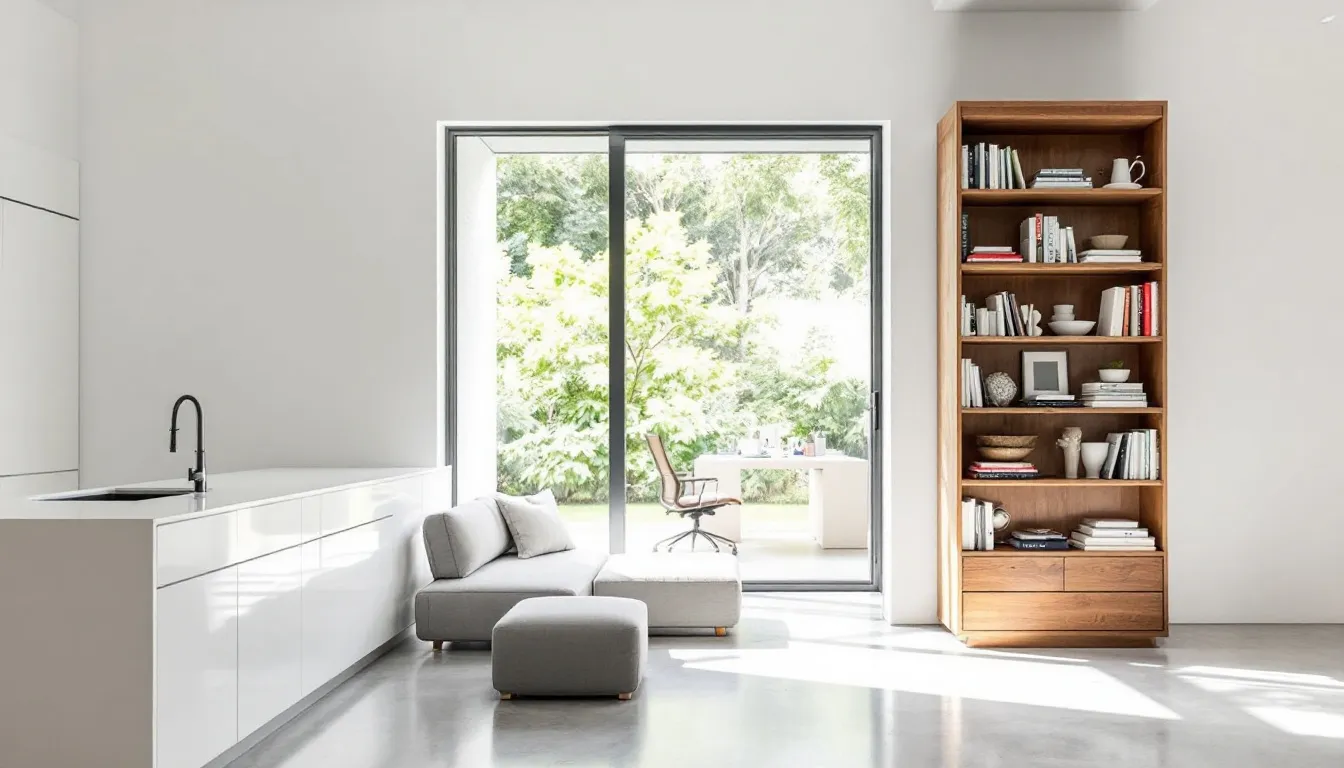Thinking about Downsizing House? This decision can save money, reduce maintenance, and simplify your life. In this guide, you’ll learn why downsizing might be right for you and how to navigate the process smoothly.
Key Takeaways
Downsizing offers financial advantages, including lower utility bills, reduced property taxes, and increased cash flow, contributing to greater financial stability.
The process of downsizing presents challenges such as emotional attachments to one’s home and the logistical stress of moving, necessitating careful planning and organization.
Successful downsizing involves practical strategies such as decluttering, maximizing space through smart storage solutions, and selecting the appropriate living arrangement, including retirement communities with ample amenities.
Why Consider Downsizing Your House?

The allure of downsizing your home often begins with the promise of financial stability. A large house comes with significant housing costs, from hefty utility bills to steep property taxes. Downsizing to a smaller house can lead to substantial savings, reducing these expenses and freeing up funds for other life pursuits. Moreover, a smaller home means less upkeep, translating to more time spent enjoying life rather than maintaining a property.
But the benefits of downsizing extend beyond financial aspects. For many, moving to a smaller space helps them focus on what truly matters. A smaller home often encourages a simpler, more organized lifestyle, where every item has its place and purpose. This shift can lead to a more mindful way of living, where the focus is on experiences and relationships rather than possessions.
Ultimately, the benefits of downsizing are multi-faceted. Financial savings, ease of maintenance, and lifestyle improvements are compelling reasons why people downsize. Whether you’re looking to save money, reduce your environmental footprint, or simply embrace a more minimalist lifestyle, downsizing offers a wealth of advantages.
Financial Advantages of Downsizing

When it comes to the financial benefits of downsizing, the advantages are clear. Moving to a smaller home can significantly lower housing costs, making it easier to save money and gain financial stability.
Three key financial advantages include lower utility bills, reduced property taxes, and increased cash flow.
Lower Utility Bills
One of the most immediate ways to save money when downsizing your home is through lower utility bills. Smaller living spaces require less energy for heating and cooling, which directly translates to decreased electricity usage and lower monthly utility bills. Imagine the relief of opening your utility bill and seeing a fraction of the cost compared to what you paid in your larger home.
Reduced energy requirements of a smaller house also contribute to a lower carbon footprint. This eco-friendly benefit allows you to enjoy life knowing you’re making a positive impact on the environment while enjoying the financial perks.
Reduced Property Taxes
Another significant benefit of downsizing your home is the reduction in property taxes. Larger homes typically come with higher property tax assessments, which can be a financial burden over time. By moving to a smaller house, you can enjoy lower property taxes, which contributes to overall financial savings.
These savings can be substantial and provide a more stable financial situation post-downsizing. Lower property taxes mean more money in your pocket, which can be used for other expenses or invested for future needs.
Increased Cash Flow
One of the most compelling financial advantages of downsizing is the potential for increased cash flow. Selling a larger property often yields substantial profits, which can be redirected towards investments or personal pursuits. This influx of extra cash provides a financial cushion that can enhance your overall financial situation.
Increased cash flow is a critical aspect of financial planning. It allows for enhanced savings and investment opportunities, ensuring that your money works for you in the long run. Whether you use the extra funds for travel, new hobbies, or simply to bolster your savings, the financial benefits of downsizing are clear.
Challenges of Downsizing
While the benefits of downsizing are numerous, the process is not without its challenges. From emotional attachments to the logistical hurdles of moving, downsizing requires careful consideration and planning.
Let’s explore two major challenges: emotional attachment and the stress of the moving process.
Emotional Attachment
One of the most significant hurdles in downsizing is the emotional attachment to your family home. The memories and emotional ties associated with a house where you’ve raised your family members or spent many years can make the decision to downsize incredibly difficult. Letting go of cherished memories can lead to stress and reluctance to make the move.
Fitting all your belongings into a smaller space can also be overwhelming. The emotional difficulty of parting with items that hold sentimental value often prevents people from considering the full benefits of downsizing.
Stress of Moving Process
The logistics of the moving process can also be a significant source of stress. Organizing possessions, coordinating with a moving company, and managing the overall chaos of moving can be daunting tasks. Without a clear plan, the entire process can lead to feelings of overwhelm and anxiety.
Creating a detailed timeline and checklist can break the moving process into manageable steps, reducing stress. Taking the time to plan ahead can make the transition smoother and less chaotic.
Planning Your Downsizing Journey

Planning your downsizing journey well in advance is crucial for a smooth transition. Starting early helps reduce stress, allows for thoughtful decisions, and ensures every aspect of the move is well-coordinated.
Let’s explore three key areas: preparing a new budget, choosing the right new home, and hiring a real estate agent.
Preparing a New Budget
A new budget is crucial when planning your downsizing journey. Account for new housing-related costs like utility bills and property taxes. The savings from downsizing can be used for travel, healthcare, or hobbies, providing a fresh start in your new home.
Additionally, if you have leftover equity from selling your larger home, you can use it for other purposes. Deciding whether to pay off your mortgage payments fully before selling can also impact your financial situation and should be considered carefully.
Choosing the Right New Home
Selecting the right new home is a crucial decision. Consider factors like closet sizes, storage space, and room dimensions to ensure your belongings fit. If your current furniture is too large, selling it and using the money to buy new furniture that fits the new space can be a practical solution.
Downsizing offers various property options, such as bungalows, flats, or smaller houses, each with its conveniences. For retirees, modern retirement communities provide resort-like amenities and accessibility accommodations, making life easier and more enjoyable.
Hiring a Real Estate Agent
A knowledgeable real estate agent can simplify the downsizing process. Real estate agents offer services like market analysis, property listings, and negotiation assistance, ensuring you get the best price for your home sale. They can also help you avoid costly mistakes and streamline the entire transaction process.
A real estate agent can effectively coordinate the timing of selling your current home and buying a new one, ensuring a seamless transition. This coordination is crucial for avoiding the stress of moving and managing housing costs simultaneously.
Decluttering and Organizing

Decluttering and organizing are key steps in the downsizing process. Reducing clutter eases the moving process and helps you adapt to a minimalist lifestyle.
Effective strategies include decluttering room by room, selling and donating items, and creative storage solutions.
One Room at a Time
Focus on one room at a time for effective decluttering. Begin with rooms used the least, such as the basement, attic, garage, or guest room, and separate items you love from those you don’t need. This approach makes the task less overwhelming and helps you gradually reduce the amount of stuff you need to move.
Tackling one room at a time allows for systematic organization and thoughtful decisions about what to keep, sell, or discard. This method ensures that you manage the process efficiently and prepare your new space effectively.
Selling and Donating Items
You can sell or donate unwanted items when downsizing. Popular online platforms such as Facebook Marketplace, Craigslist, eBay, and Poshmark can help you sell belongings you no longer need. This not only helps you reduce clutter but also provides extra cash that can be used for other expenses.
Alternatively, donating items to organizations like Goodwill, Salvation Army, and local charities is another excellent way to declutter. It ensures that your belongings find a new home where they are needed and appreciated.
Storage Solutions
Renting a storage unit can be a practical solution if you’re struggling with space during downsizing. It allows you to keep items you want but can’t immediately accommodate in your smaller living space. This flexibility can make the transition more manageable and less stressful.
Built-in shelves, hidden compartments, and under-bed storage containers can help maximize space in your new home. These solutions ensure that your living spaces remain organized and clutter-free, making your smaller home feel more spacious and functional.
Maximizing Your Smaller Space

Maximizing a smaller living space requires thoughtful planning and smart solutions. Incorporate space-saving furniture and innovative storage options to make the most of your new home.
Let’s explore these strategies in more detail.
Space-Saving Furniture
Dual-purpose furniture is essential for smaller living spaces. Convertible furniture, such as a sofa bed, provides versatility and maximizes functionality. Nesting tables can be easily stored away when not in use, saving valuable floor space.
Furniture like beds with built-in drawers or ottomans that double as coffee tables can enhance space efficiency. These multi-purpose items ensure that every piece of furniture serves more than one purpose, making your smaller home more functional and comfortable.
Smart Storage Solutions
Smart storage solutions are crucial for keeping your new home organized and clutter-free. Utilizing built-in shelves can effectively maximize storage while maintaining a stylish look. Creative storage options like hidden compartments and pegboards can keep spaces organized without adding clutter.
Furniture with storage capabilities and under-bed storage containers can reduce the need for additional pieces, optimizing your smaller space. These solutions ensure that your living spaces remain functional and aesthetically pleasing.
Downsizing to a Retirement Community
For many older adults, downsizing to a retirement community offers a host of benefits beyond just a smaller living space. These communities are designed to cater to the needs of retirees, providing a lifestyle that is both convenient and enriching. One of the primary advantages is the significant reduction in home maintenance tasks. Residents can offload most of the upkeep responsibilities, saving time and money.
Retirement communities often feature a wide range of amenities, such as pools, fitness centers, libraries, and hobby rooms, catering to various interests and promoting an active lifestyle. These amenities are designed to enhance the quality of life for residents, making everyday living more enjoyable and fulfilling. Additionally, the social opportunities available in these communities foster connections among residents, helping to mitigate feelings of loneliness and promoting overall well-being.
Accessibility is another critical feature of retirement communities. Many are designed with single-floor living spaces to accommodate residents with mobility challenges, ensuring that everyone can move around comfortably and safely. This focus on accessibility and convenience makes retirement communities an attractive option for those looking to downsize their large homes.
Summary
Downsizing your home is a significant decision that comes with both benefits and challenges. Financial advantages such as lower utility bills, reduced property taxes, and increased cash flow can provide substantial relief and stability. However, the emotional attachment to your family home and the stress of the moving process are hurdles that need to be carefully managed. Planning ahead, decluttering, and choosing the right new home are crucial steps to ensure a smooth transition. Whether you opt for a smaller house or a retirement community, the journey of downsizing can lead to a more focused, organized, and fulfilling lifestyle. Embrace the change, and you’ll find that less truly can be more.
Frequently Asked Questions
What are the main financial benefits of downsizing your home?
Downsizing your home can substantially lower your utility bills, reduce property taxes, and enhance your cash flow by generating proceeds from the sale of a larger property. These financial advantages can contribute to greater financial stability and flexibility.
How can I manage the emotional attachment to my family home when downsizing?
To manage emotional attachment when downsizing, it is essential to acknowledge the memories tied to your family home while prioritizing the advantages of financial stability and a more simplified lifestyle. Embrace the positive aspects of this transition for a smoother adjustment.
What are some effective strategies for decluttering when downsizing?*
To effectively declutter when downsizing, concentrate on one room at a time, begin with less frequently used areas, and categorize items into keep, sell, and donate groups. This structured approach will streamline the process and make decision-making easier.
Why should I consider hiring a real estate agent for the downsizing process?
Hiring a real estate agent for downsizing can significantly simplify the process by leveraging their expertise in market analysis, property listings, and negotiation, while effectively coordinating the sale and purchase timing. This professional guidance can ensure a smoother transition during a potentially overwhelming time.
What are the benefits of moving to a retirement community when downsizing?
Moving to a retirement community provides the advantages of minimal home maintenance, a range of amenities, enhanced social engagement, and living environments tailored for accessibility and convenience. These features can significantly enhance quality of life during retirement.
